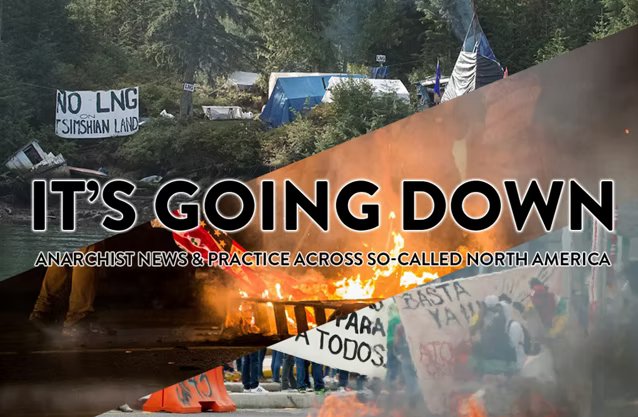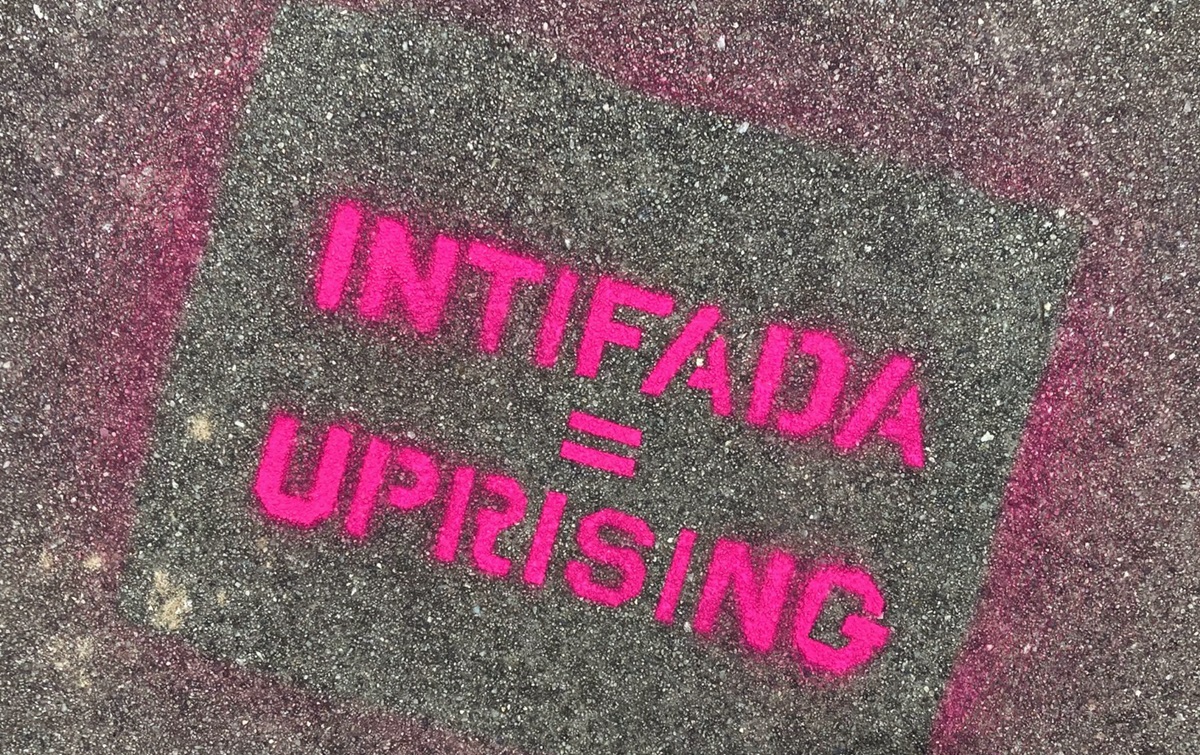Filed under: Anti-fascist, Editorials, Trumpism, US, White Supremacy

If you want to bring death to the Klan don’t talk about it. If you want to bring death to the Klan then organize and bring death to the Klan.
Alfred “Skip” Robinson
Originally posted to It’s Going Down
by Ben Jones and Alexander Reid Ross
Against Two Klandidates
Actions against Trump have increased in intensity and pace since it began last year. Listing the litany of reasons for this would be virtually impossible. His lies veiled as politics; his actual history and network; his unapologetic reception of David Duke’s support; his Mussolini reference, taken up by a pro-Trump militia; his threats of riots and attacks.
The two dominant alternatives to Trump seem equally terrible. Ted Cruz’s call for patrols in Muslim neighborhoods evokes the legacy of white posses, and is so racist that even the NYPD rebuked him. Hillary Clinton was recently endorsed by the California Invisible Empire Klan Grand Dragon.
However, Trump’s own applause for land grabs and his economic background as a high-rolling speculator indicate another reason for opposition. Trump’s father, Fred Trump, made his fortune first building single family homes during the Depression in Brooklyn, and then apartments during the boom following WWII. When Trump took over the family business in the 1970s, he shifted focus to luxury residences and casinos—symbols of the exploits of capital. He has gone through bankruptcy four times, most recently in 2008, when he was rescued by the financial crash through a clause in his contract excepting an “act of God” (and yes, Trump did actually argue publicly that the housing market crash was caused by God).
While people were evicted from those single-family homes and apartments build by his father, Trump continued to live the high-life, with the conspicuous consumption of his hotels, casinos, and golf courses serving as landmarks of the 1%.
Chip Berlet is correct in strategizing a defensive movement by “organizing now to protect the people being demonized and scapegoated as targets of White rage,” and calling for people to “build broad and diverse local coalitions that tactically address local issues while strategically linking them to national struggles.” This involves acting within the evolving social movements against white supremacy, and with smaller, local, and often-overlooked formations that focus on specific issues, pushing to exit the radical and activist bubble.
Page May, an organizer with #ByeAnita which took a leading role in Chicago’s anti-Trump shut-down, said that anti-Tump is an “opportunity to connect the dots between what’s happening here locally in Chicago and particularly the state’s attorney position, and how that’s connected to the national politics of the moment.” The organizers galvanized national rejection of Trump to demonstrate against incumbent Anita Alvarez, who has neglected to act on the police murder of Dante Servin and other acts of police violence. Another organizer, Veronica Morris Moore reflected on the national-to-local rally, commenting, “We tied the fascist politics all into one.” One of our tasks as revolutionaries, is to push for a critique of the State as a totality of violence, and to not rely on reformist or electoral strategies.
To gain some perspective about the kind of movement we’re talking about, here’s a non-exhaustive list of anti-Trump Actions:
2015
- June 29th: About 100 protesters outside Chicago rally.
- October 23rd: Repeatedly interrupted at Miami rally.
- November 18th: Sporadic interruptions at Worchester rally.
- December 4th: Ten interruptions at Raliegh rally.
- December 11th: – About a dozen protesters interrupt NYC event.
- December 14th: Interruptions and fighting at Las Vegas rally.
January 2016
- 4th: Frequent interruptions at Lowell rally.
- 8th: Multiple disruptions at Burlington rally in addition to a separate anti-Trump demonstration in the city.
- 13th: Small protest outside Pensacola rally.
- 20th: Tulsa rally interrupted with a banner.
- 27th: Pelted with tomatoes at Iowa City rally.
- 28th: Interruption at Des Moines event.
February
- 1st: Pro- and anti-Trump rallies in Seattle.
- 7th: Students protest outside Plymouth rally.
- 14th: Hundreds of protesters outside Tampa rally.
- 18th: Interruption and fighting at Augusta rally.
- 19th: Myrtle Beach rally interrupted with a banner.
- 19th: Anti-Trump piñata bash outside Houston debate.
- 22nd: Lights are cut during Atlanta rally.
- 23rd: Disruptions at Las Vegas rally.
- 23rd: Pickets outside of Trump hotels in Las Vegas.
- 28th: Small demonstration outside Madison rally.
- 29th: Interruptions and fighting at Radford rally.
March
- 3rd: Repeated interruptions and fighting at Louisville rally.
- 4th: Frequent interruptions at New Orleans rally.
- 5th: Frequent interruptions at Orlando rally.
- 7th: Multiple interruptions at Concord rally.
- 9th: Multiple interruptions at Fayetteville rally with protests outside.
- 11th: Interruptions and fighting at St. Louis event.
- 11th: Fighting at cancelled Chicago rally followed by clashes with the police in the street.
- 12th: Stage stormed by protester during Dayton rally.
- 13th: Repeated interruptions and fighting at Kansas City rally.
- 15th: Protests outside West Chester rally.
- 19th: Blockade outside of Fountain Hills rally.
- 19th: Fighting at Salt Lake City rally.
There has also been extensive vandalism at Trump’s campaign offices, graffiti and wheatpastes, as well as other autonomous actions that have no formal agents or organizations. Trump has recently resumed touring after his longest break since Christmas, likely as a result of the confrontations. It’s certainly a welcome departure, but it also helps give more perspective on what these networks could accomplish if they stuck together without Trump to militate against.
These actions are generally not part of a coordinated effort to undermine political institutions—although they could possibly provide an interesting model for autonomous, spontaneous organizing. What needs to happen is to expand this beyond a campaign against a candidate, but what he represents—a position of power that most assuredly other candidates would fill. Cruz could be even worse than Trump—the focus on Trump for the time being is a providential unifying point, but there are much deeper issues at play that would move on to other candidates with the same message.
Telling people who to vote for or not vote for typically offers little in terms of rewards. Such ideology policing tends to come off as pedantic. The process is de-legitimized, and there is no stress on radicals to point people to that frustration. The point is rather to redirect that anger toward anti-systemic action.
Rejection of Republican politics is still not “sheepdogging” for the Democrats or for social democracy, for that matter. Politics is less a zero-sum game than a navigation of everyday political nuances and categories. “Either protest everything at once, or whatever your protesting is going to help all the other things,” may seem like a powerful claim, but in reality, it is totalizing. What if people who stood against Trump didn’t vote for someone else, but joined in resistance at a local level?
A Transformative Movement?
From Clinton or Bush to Gore or Bush and eight years deep into Obama only to return to Clinton, more and more people are refusing to support the electoral system of the United States of America. There has not been in our lifetime a point where the US electoral system has been so discredited. Rather than stand by the wayside, there is wisdom in looking at the growing movement in its developing autonomous power, and recognizing intersections of collective liberation.
The trouncing of Clinton in Washington points to a kind of “new Washington consensus.” The first Washington Consensus formed the basis for neoliberalism in the 1970s—deregulation, austerity, privatization. In the state that gave us Starbucks, the symbol of Clinton-era neoliberalism, the old Washington Consensus has been rejected in favor of a social democratic alternative. However, the idealism surrounding Sanders outstretches possibility in electoral politics, and his candidacy remains a longshot with odds stacked against him. Claims that Sanders could “lead a political revolution,” through a post-election strategy should be thrown out entirely. Sanders’s politics are not revolutionary whatsoever.
That’s the real post-election strategy, and it can be better actuated by demonstrating against a candidate who provides a providential intersection around which many different groups can organize autonomously for collective liberation than demonstrating in favor of a “revolutionary leader” who represents a political bailout for a discredited system.
Yet there is a fatal flaw in our thinking if we do not recognize crucial defensive measures that must be taken, along with demonstrating against Trump. One hears a lot about “Death to the Klan” when three people are stabbed by a Klansman, but there is little perspective over the fact that the slogan itself was raised during an unsuccessful campaign that lead to the murders of five anti-Klan protestors in 1979. Similarly, we hear much about how Hitler claimed that the only thing that might have stopped him would have been counter-protesters breaking up his meetings. Yet there is little understanding of the fact that such protesters did exist in numbers. Thousands organized to break up Nazi meetings in the years between 1919 and 1923, leading Hitler to create his hall security force, which would develop into the paramilitary Sturmabteilung (SA). The militant opposition congealed under Social Democrat leadership as the Reichsbanner and the Iron Front, under the Communist’s Red Front and in the Ruhr, the Anarcho-Syndicalist Free Union of German Workers. In Austria, it was the Schutzbund who would end up fighting a bloody civil war against the fascist Heimwehr in 1934. The difference was not made by the refusal to fight, but by the fact that the SA and other various paramilitary groups of the “Patriotic movement” were equipped and protected by the German Reichswehr (army) in accordance with the policies of Social Democrat Gustave Noske, and given a free pass by local officials in Bavaria (particularly Franconia) and elsewhere.
The line about destroying Trump’s candidacy by breaking up his rallies is important, but it’s also inflated unless there is a focus on defensive measures. In particular, given Trump’s prediction of riots if he is rejected by the Republican National Convention, there is every reason to assemble for local, autonomous self-defense.
It is wrong to insist that the escalation of antifascist tactics that we have seen will lead necessarily to an escalation on the right—but that does not mean we should not expect such an escalation to emerge. We must maintain pressure on Trump’s campaign, because of the accumulation of capital and oppression that he symbolizes, while also taking defensive measures. Even though neo-conservatives like William Krystal are rallying behind Clinton as she embraces the legacy of Ronald Reagan and George Bush, Jr., Trump’s “anti-establishment” populism still makes him a threat—particularly after the election should he lose.
If Trump is dog-whistling “riot” to his supporters in the primaries, imagine what he would be saying if nominated for president. Trump’s support within the Republican Party is not even close to a majority, and it is possible that much of the GOP would not vote for him if he is nominated. However, if the Republican Party loses a third straight time—this time to a female establishment politician—there is the further possibility of the Party fracturing into increasingly militant groups prepared to fight with increased vitriol, making the expansion of the militia movement after Bill Clinton and Obama’s elections look like small potatoes.
Matthew Lyons is right to state that part of a strategy to defeat not just Trump but radical right wing populism is giving “people better ways to channel that rage, radical alternatives that speak to their reality.” Passivity is impossible. There is potential. There is possibility. There is a future we can build together. People are rising up against the oligarchy, represented in the real estate mogul who controls the land, the history of Americanism that he represents, and its joint roots in slavery, genocide, fascism, and the Red Scare; in the Klan and the police; the mines and the prisons.





